Key takeaways:
- Rejection serves as a valuable learning experience, highlighting areas for improvement and fostering a growth mindset.
- Understanding the reasons behind a proposal’s rejection, such as unclear objectives or misalignment with funder priorities, is crucial for future success.
- Feedback from rejections is an opportunity to identify patterns and enhance proposal quality through collaboration and reflection.
- Building resilience involves reframing setbacks, documenting feedback, and allowing time for creative brainstorming after rejection.
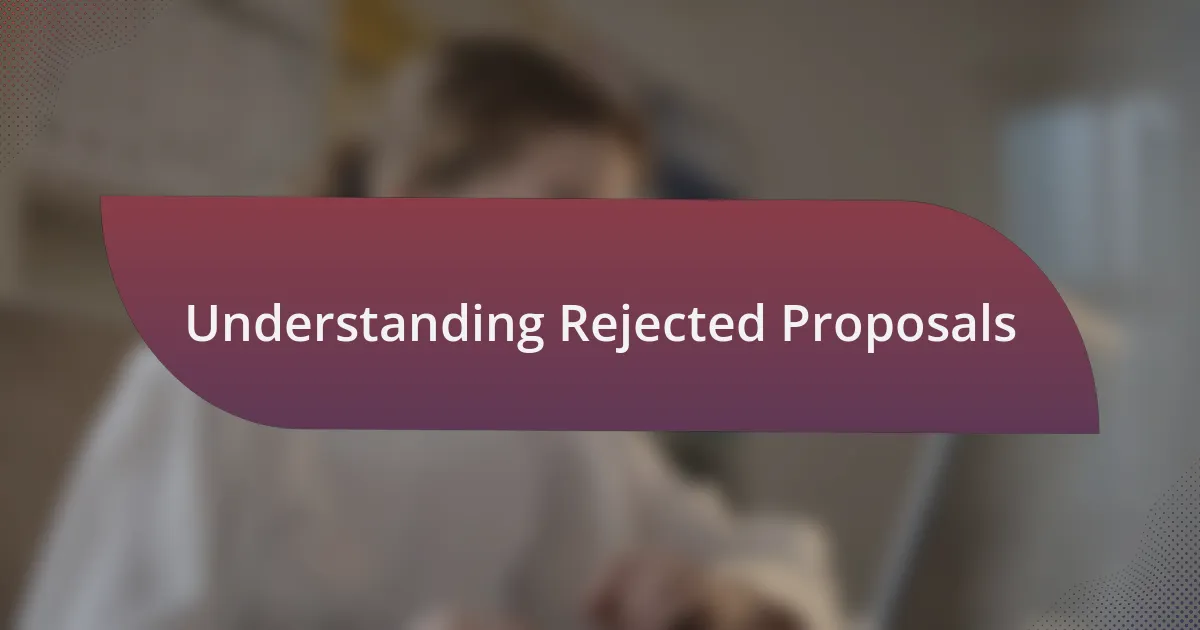
Understanding Rejected Proposals
Understanding rejected proposals can be tough, and I remember the first time I faced rejection in my work. It stung, to say the least. The proposal I had poured my heart and soul into was dismissed. While it was painful, it taught me something invaluable—every rejection is a learning experience just waiting to unfold.
When I reflect on those moments, I often wonder, what could I have done differently? Each rejection sheds light on areas for improvement. Maybe it was my approach, the clarity of my objectives, or even the alignment with funders’ priorities. Analyzing these factors not only reveals insights into my work but also helps foster a growth mindset for future proposals.
In my experience, understanding the reasoning behind a rejection is crucial. I found that many times, reviewers highlighted specific gaps or concerns that, although tough to hear, provided a roadmap for enhancement. It’s like receiving feedback from a mentor—they may not sugarcoat it, but it’s ultimately aimed at helping you succeed. Acknowledging this perspective transforms rejection from a setback into a stepping stone.

Importance of Proposal Rejection
Proposal rejection plays a crucial role in professional growth. I recall a time when my team submitted a proposal that we were confident would succeed. When it was rejected, the initial disappointment felt overwhelming. However, that rejection opened my eyes to critical aspects we had overlooked. It made me realize that each “no” has the potential to refine our approach and elevate the quality of our future submissions.
When mulling over what went wrong, I discovered that feedback often carries the key to our evolution. We tend to view rejection as a closed door, but it’s actually an invitation to deeper understanding. For me, this meant revisiting our objectives and ensuring they align more closely with funders’ expectations. Have you ever considered how a rejection could be the very nudge you need to innovate and adapt?
Learning from rejection turns a frustrating experience into an opportunity for considerable improvement. It’s a humbling reminder that perfection is a journey, not a destination. Reflecting on my past proposals, I’ve realized these moments of rejection often precede breakthroughs. Instead of dwelling on the loss, I started to ask, “What insights can I extract from this experience?” This shift in perspective not only alleviated the sting but fueled my commitment to grow.
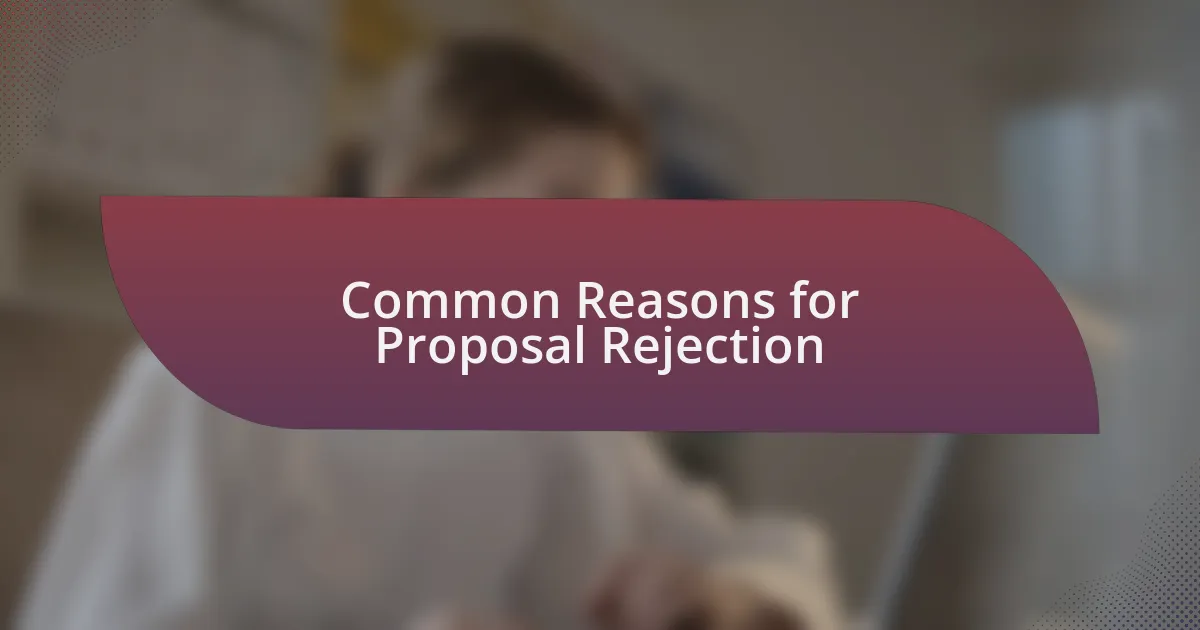
Common Reasons for Proposal Rejection
One common reason proposals face rejection is the lack of clear objectives. I remember pouring my heart into a proposal only to realize later that our goals were vague and poorly defined. Without clarity, how can funders possibly grasp the significance of our work? So, have you asked yourself if your objectives are crystal clear in your submissions?
Another frequent pitfall is the misalignment between the proposal’s focus and the funder’s priorities. Early in my career, I submitted a project that I was enthusiastic about but failed to tie it directly to the funder’s mission. The rejection stung at first, but it taught me the essential lesson that every proposal must connect to the broader goals of potential supporters. Have you taken the time to thoroughly research the interests of your audience, ensuring your ideas resonate with their objectives?
Lastly, inadequate research often leads to rejection, particularly when proposals lack supporting data or evidence. I once submitted a proposal that was ambitious but ultimately unsound because it failed to include credible studies to back my claims. It hit me hard when the feedback pointed to our weak foundation. This experience pushed me to prioritize thorough research, not just to strengthen proposals but to bring authenticity to my arguments. What could you change today to ensure your next proposal is built on solid ground?
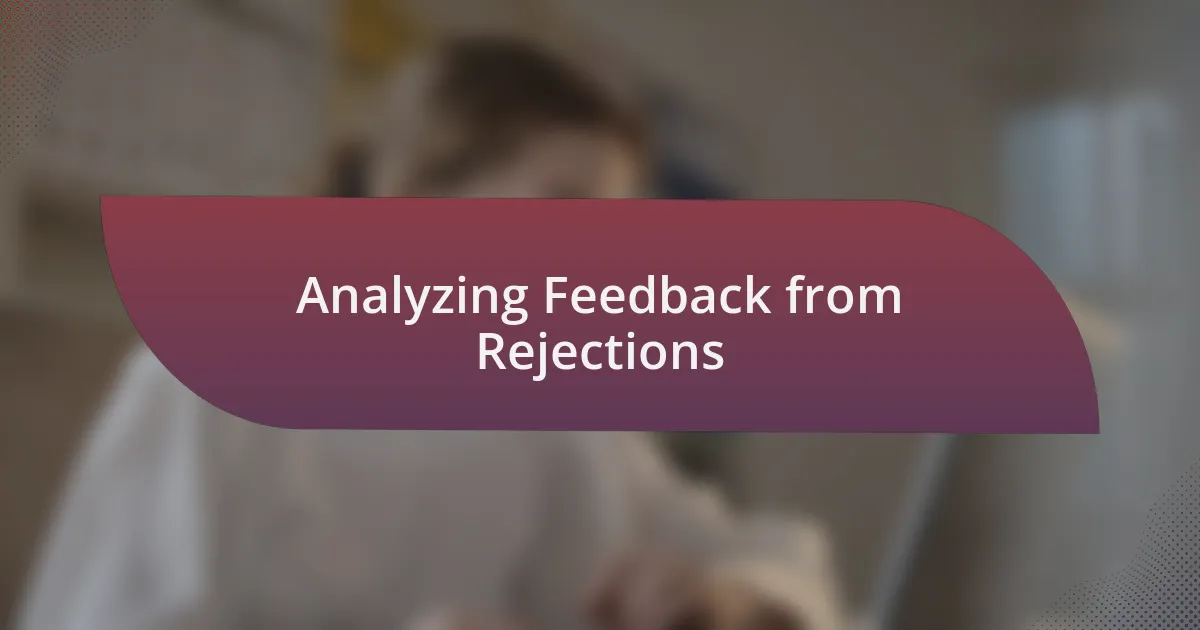
Analyzing Feedback from Rejections
When I receive feedback after a proposal rejection, it feels like a punch to the gut initially. Yet, I’ve learned that each piece of feedback is a treasure trove of insights waiting to be uncovered. For example, a reviewer once pointed out vague methodologies in my submission. At first, I was defensive, but I soon realized it was a genuine concern; I had assumed the reviewers would fill in the gaps instead of explicitly guiding them through my reasoning. How often do we let our assumptions cloud our clarity?
One critical takeaway from analyzing rejection feedback is recognizing patterns over time. I used to treat each rejection as an isolated incident until I began to see recurring themes. Whether it was insufficient stakeholder engagement or a lack of budget clarity, these patterns helped me reshape my approach in subsequent proposals. Have you noticed similar trends in your work that could signal a need for adjustment?
Moreover, the emotional aspect of feedback can’t be overlooked. After one rejection, I felt disheartened but made it a point to stretch beyond my initial feelings of inadequacy. Diving deeper into the feedback led me to specific areas of growth—like enhancing my data visualization skills, which ultimately transformed the clarity of my future proposals. Reflecting on your emotional reactions when facing feedback, what insights might emerge that could guide you toward improvement?
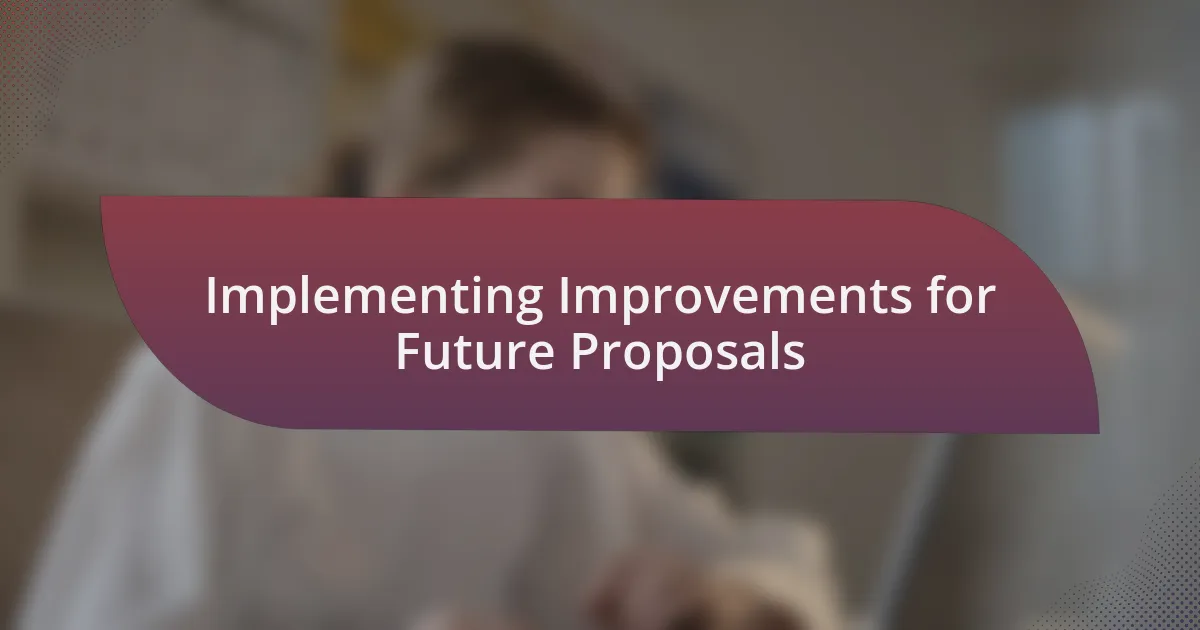
Implementing Improvements for Future Proposals
To implement improvements for future proposals, I’ve started creating a comprehensive checklist based on the feedback I’ve received. This checklist allows me to systematically address previous weaknesses, whether it’s refining my objectives or ensuring that my methodology is clear and compelling. I remember the time a reviewer urged me to elaborate on my anticipated outcomes; now I always make that a central component of my proposals. Have you considered developing a similar tool to enhance your submissions?
It’s also essential to involve other perspectives in the proposal crafting process. I began organizing brainstorming sessions with colleagues to unpack complex ideas. Just last month, I had a discussion with a peer who pointed out potential blind spots in my assumptions about community needs. That conversation not only refined my approach but also made me realize how collaborative efforts can dramatically strengthen a proposal’s foundation. Do you seek feedback from others before finalizing your work?
Furthermore, I’ve adopted a habit of reflecting on each proposal experience, regardless of the outcome. By journaling my thoughts after each submission, I’ve pinpointed what strategies resonated and which ones fell flat. This practice gave me clarity after a particularly tough rejection last year; I had poured my heart into that proposal, and the setback felt heavy. Yet, reviewing my notes revealed overlooked details that I can improve upon. How might personal reflection transform your approach to future projects?

Case Studies of Successful Resubmissions
When I think about successful resubmissions, one case that stands out is a project I worked on aimed at improving local educational outcomes. After an initial rejection, I went through the review feedback meticulously and realized that my data interpretation wasn’t as robust as it could be. By incorporating additional statistical analysis and supplemental studies supporting my claims, I was able to resubmit a much stronger proposal that ultimately secured funding. This experience reinforced the importance of not just accepting criticisms but actively using them to enhance the proposal’s strength.
In another instance, I collaborated with a colleague whose proposal had been turned down due to unclear objectives. We spent weeks revising it together, focusing on sharpening the goals and aligning them more closely with the funder’s priorities. The clarity we achieved was gratifying—seeing our hard work pay off when the resubmission was accepted felt incredibly rewarding. Have you ever partnered with someone to refine your ideas? This collaboration opened my eyes to the benefits of diverse perspectives and shared knowledge.
I also recall a project centered on environmental policy, where the initial submission faced stiff criticism for lack of community engagement. I took that feedback to heart and reached out to community stakeholders for their insights before resubmitting. Their input not only enriched the proposal but also crafted a narrative emphasizing community involvement. The excitement I felt upon receiving notification that the proposal was accepted reminded me that addressing feedback with openness can lead to transformative results. What changes could you make today to invite more stakeholder engagement in your work?
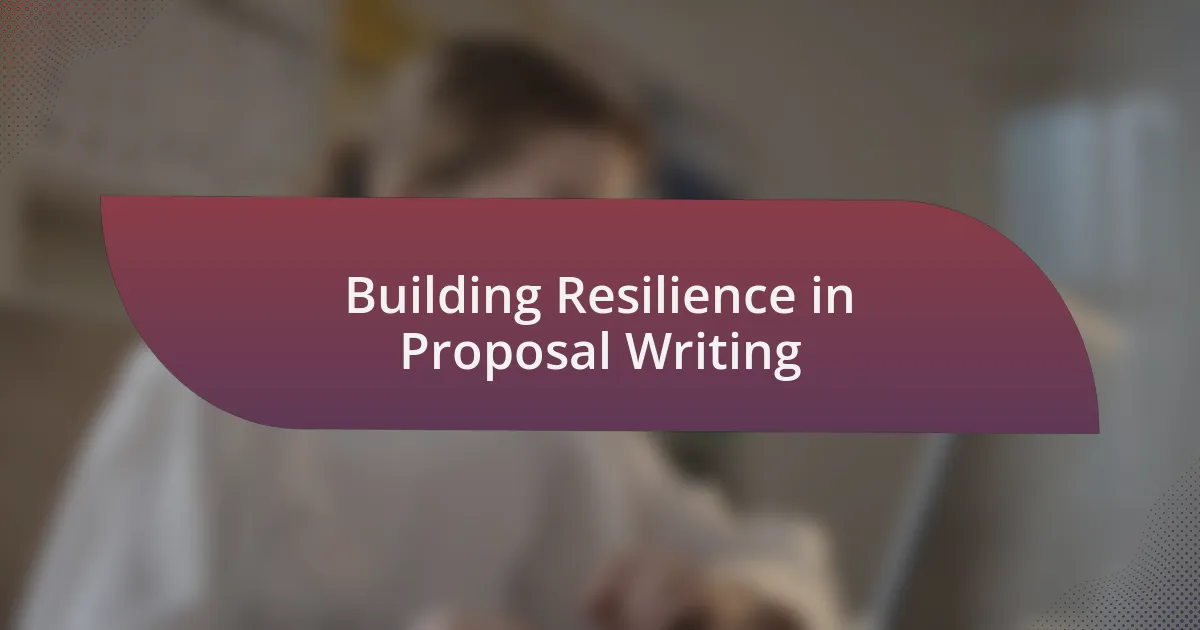
Building Resilience in Proposal Writing
Building resilience in proposal writing is essential, especially after facing rejection. I remember a time when I felt disheartened by my proposal’s outcome. Instead of wallowing in disappointment, I took a step back and reframed the entire experience as an opportunity for growth. How often do we see setbacks as stepping stones rather than obstacles? This shift in perspective helped me focus on what I could learn from the process.
During this journey, I developed a habit of keeping a detailed log of feedback received from reviewers. After one rejected proposal, I meticulously categorized the critiques. This not only made it easier to address specific concerns in subsequent submissions but also gave me a sense of control over the revision process. Have you ever documented feedback to track your progress? I found that this practice not only honed my proposal-writing skills but also encouraged me to embrace constructive criticism with an open mind.
Resilience also manifests in how we approach our writing routines. I’ve learned to set aside time for reflection after a rejection, allowing myself to process my emotions fully. This time serves as a mental reset, where I can brainstorm new ideas or approaches without the pressure of immediate submission deadlines. It’s liberating to ask myself, “What creative angles can I explore next?” By nurturing this resilience, I found that my proposals became more innovative and aligned with my true passions.